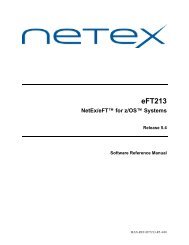Software Reference Manual - NetEx
Software Reference Manual - NetEx
Software Reference Manual - NetEx
You also want an ePaper? Increase the reach of your titles
YUMPU automatically turns print PDFs into web optimized ePapers that Google loves.
connect to the BFXJSTAT function on the remote host to determine whether the BFXTR job failed or<br />
is still awaiting execution. If it failed, it will print out a message received from the remote job status<br />
function on the remote host. If the job is still awaiting execution, then the BFXTI job will reoffer itself<br />
for the TIMEOUT value. This process will continue until the BFXTR job finally executes or<br />
leaves the input queues. See the comments on the RMTJOB parameter in “Job Status Function Request<br />
Component (BFXJSTAT)” on page 31.<br />
Note that the remote job status function must be started by the user on the remote system in the same<br />
way that the BFXJS function is started (entering START BFXSTAT for example).<br />
If this parameter is not supplied, this feature will not be used. Note that not all systems that use BFX<br />
have the remote job status function.<br />
- (line continuation character)<br />
This character may be used in the SYSIN parameter file to indicate that more parameters for the same<br />
transfer are on the following line.<br />
CLOSE and NOCLOSE<br />
This is an optional parameter (abbreviated CLO and NOC) that specifies whether SCLOSE should be<br />
used to terminate the file transfer or not (instead of SDISC). If SCLOSE is used, any other BFX<br />
components to be communicated with (BFXTI, BFXTR, BFXJS) must also use SCLOSE. It is recommended<br />
to use SCLOSE if all BFXs support it.<br />
If this parameter is not supplied, an installation-defined default is used.<br />
TIME and NOTIME<br />
These optional parameters (abbreviated TIM and NOT) specify if a time of day timestamp is to precede<br />
all BFX generated messages (TIME) or not (NOTIME).<br />
If present, the timestamp will take the form hh.mm.ss (where hh = hours (24-hour clock), mm = minutes,<br />
and ss = seconds).<br />
If this parameter is not supplied, an installation-defined default is used.<br />
UPPER and UPLOW<br />
These optional parameters (abbreviated UPP and UPL) specify if the messages that are to be placed<br />
in the SYSPRINT log file are to be printed in uppercase only (UPPER) or in mixed-case (UPLOW).<br />
If this parameter is not supplied, an installation-defined default is used.<br />
MAN-REF-H211-05 JCL and Control Parameters for BFX Page 21















